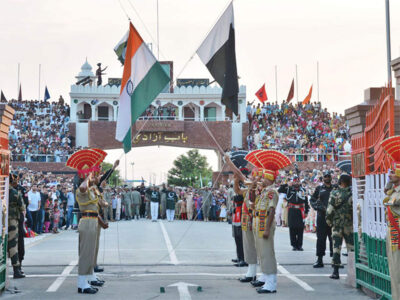Syed Ali Zia Jaffery
In his seminal book titled When Proliferation Causes Peace: The Psychology of Nuclear Crises, political scientist Michael D. Cohen argues that the psychology and experiences of leaders of nuclear states determine the impact that nuclear weapons have on foreign policy choices. He writes that ‘leaders of new nuclear powers tend to authorise assertive foreign policies and accept the risk of nuclear escalation until those leaders experience fear of imminent nuclear war themselves.’ Therefore, as Cohen rightly says, nuclear risks are partly engendered or attenuated by leaders’ behaviours. While Cohen’s characterisation of choices that leaders of nuclear states make could certainly be challenged, the importance he attaches to assessing the role that individuals play in increasing or decreasing nuclear risks cannot be ignored. Academic analyses and disquisitions on leadership have become all the more important in today’s fraught environment, which is being shaped by populist leaders. Also, with leaders stewarding hundreds and thousands of nuclear weapons, their role in reducing nuclear risks is all-important and merits attention. However, with competitions between nuclear states increasing precipitously, leaders will have their work cut out, and therefore need to understand that averting nuclear showdowns is a shared goal and responsibility.
The prospect of understanding and accepting this argument will hinge on the ability of states and their leaders to do two things. First, they would have to resist the urge to call their adversaries ‘irresponsible’ and themselves ‘responsible’. Second, they would have to realise that there are many stakeholders towards whom nuclear states have responsibilities. All this means that the nature of conversations on and about nuclear weapons will have to change, and that, in the absence of a visionary leadership, any change may neither be possible nor helpful. In my engagements with the BASIC-ICCS’ Programme on Nuclear Responsibilities, not least through the platform of the Center for Security, Strategy and Policy Research (CSSPR), I identified three ways through which leaders can help not only fulfil, but also communicate their states’ nuclear responsibilities more effectively.
First, political and military leaders, who are responsible for devising and articulating nuclear policies, could change their countries’ storylines. Rather than castigate their nemeses’ irresponsible actions, officials should focus on highlighting how their states have fulfilled their responsibilities. Any Pakistani premier, for example, could, in his parleys with the international community, speak to the country’s ever-improving nuclear safety and security protocols.
Obviously, given the history and trajectory of the nuclear-tinged India-Pakistan rivalry, it would be extremely difficult for a Pakistani leader to not mention India’s hawkish behaviour. However, it is important to understand that, expending time on identifying and, in some cases, amplifying what wrong the other side is doing, will shrink the space for shedding light on one’s own correct actions. Therefore, with a view to not only softening rhetoric but also improving images, leaders could make a conscious effort to reorient and reframe the discourse on nuclear weapons. This is not to suggest, in any manner, that deterrent threats should not be issued. If anything, the Nuclear Responsibilities Approach and its elaborate Responsibilities Framework allow officials and other stakeholders to talk about all responsibilities, including but not limited to deterring adversaries. So, centering the debate on exploring, understanding, and highlighting one’s own responsibilities is critical to lowering the levels of distrust.
In this regard, leaders must avoid making reckless remarks, not least because while they do not translate into credible threats, they do create unneeded and dangerous war hysteria. Responsible leadership can put an end to subversive jingoism. While doing so appears to be a tall order, substantive engagements with the Approach may provide a way out. The Approach, it must be stated, could give a state’s officialdom a fair idea of how broad the spectrum of responsibilities is. Moreover, the Approach would also suggest that dishing out threats via various media platforms will only exacerbate tensions and risks.
Second, decision makers could better fulfil their countries’ nuclear responsibilities if they take into account not only the sources they emanate from, but also the stakeholders toward which these are targeted. If decision makers fully understand that, by virtue of being in the driving seats of nuclear states, their statements and decisions will have far-reaching ramifications.
As those who set the tone for narrative-building, leaders dabbling in nuclear decision-making could assure and reassure multiple audiences that they are committed to fulfilling their responsibilities towards all stakeholders. Doing so would, for instance, mean that leaders would go the extra mile in assuaging concerns about non-use of nuclear weapons against countries other than adversaries. Other than speaking to a nuclear state’s desire to promote stability, a reassurance from the Pakistani officialdom that its nuclear weapons are not against any other country than India would increase the deterrent value of the said weapons against the former.
Therefore, the leadership, knowing that there are many entities towards whom Pakistan has responsibilities, will help it refine its messaging to the world. It would not be wrong to say that the onus of packaging a nuclear state’s achievements without antagonising the enemy is squarely on its leadership. The Nuclear Responsibilities Approach will certainly be useful in apprising leaders of the critical role they ought to play in all this.
Thinking about multifarious responsibilities towards different stakeholders is also critical to resolving conflicts between competing goals and responsibilities. For example, when leaders will think about their countries’ responsibilities towards adversaries and the environment, they will be able to chalk different ways to address variances. Perhaps in this case, the messaging would have to be segmented. This is one area which will test leaders. A more careful analysis of the Approach suggests that, wittingly and unwittingly, states and their leaders become complacent as far as fulfilling responsibilities is concerned. Therefore, it is imperative that leaders see things from a much bigger prism than they did before.
Third, leading a nuclear state demands a recognition that disparate stakeholders, including citizens, have nuclear responsibilities. One of the takeaways from the seminars I conducted exploring Nuclear Responsibilities in the Pakistani context with students from the University of Lahore and other universities in Lahore was that there is a sheer lack of nuclear literacy in the country. Despite being the most important stakeholders, Pakistani citizens are not cognisant of nuclear issues, let alone their nuclear responsibilities. This is primarily because nuclear weapons are seen as the preserve of a small community of experts and officials. Hence, it is important for the Pakistani leadership to democratise the debate, not least by providing greater access to scholars and professionals who are willing to, and capable of, narrating Pakistan’s told and untold stories. This is important for both Pakistani and international audiences.
Pakistan, it must be stressed, has taken great pains to fulfil its responsibilities towards friends and foes alike. However, owing to a dearth of original research, those efforts haven’t been spoken of vociferously at the political level, or acknowledged in the academic domain. This has only hurt Pakistan’s cause. All this can be bettered only if the leadership understands the importance of opening up the debate surrounding Pakistan’s nuclear program. Therefore, apropos of Pakistan, it is essential that the country’s leadership decides to facilitate Pakistanis who want to know and academically scrutinise the country’s remarkable nuclear journey. Here, it is important to remind readers that it was the foresight of a group of Pakistani leaders that allowed young professionals to deliver a nuclear deterrent for Pakistan. Thus, a forward-looking approach to leadership is needed to update the world on where the 25-year-old Nuclear Pakistan stands right now.
In sum, it would be reasonable to suggest that leaders of nuclear-armed countries need to step up to the plate in order to communicate that they are fulfilling their responsibilities towards different stakeholders and audiences. They could use their mandates to recalibrate discussions about nuclear weapons. Through effective communication, they could show resolve and restraint at the same time, and that too without resorting to recrimination. Further, efforts to rewrite their nuclear talking points could be complemented not only by understanding that there are multiple stakeholders towards whom states have responsibilities, but also by trying to democratise discussions around nuclear weapons. All this suggests that if leaders cling to their old approaches in dealing with nuclear-related issues during peacetimes and crises, the future of nuclear risk-reduction will become bleaker.
This article is also published on the British American Security Information Council (BASIC) website.
Syed Ali Zia Jaffery is Deputy Director, Center for Security, Strategy and Policy Research (CSSPR), University of Lahore.








Comments